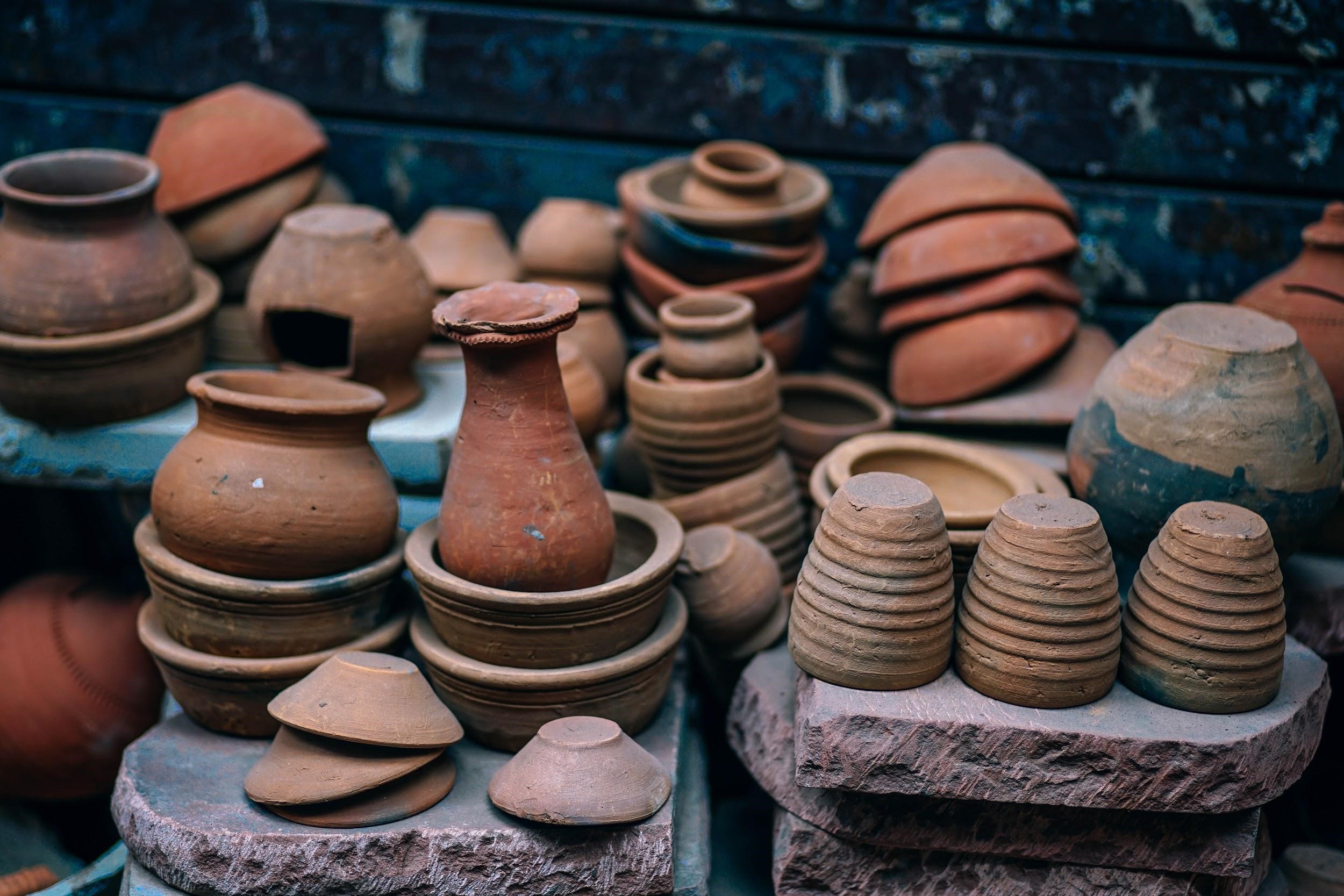Industries based on Size
The amount of capital invested, the number of workers employed and the volume of production determine the size of the industry. Consequently, industries may be divided into household or cottage, small-scale and large-scale.
- Household industries or cottage manufacturing – It is the smallest manufacturing not. The workers or artisans use local raw materials and simple hand tools to produce daily use goods in their houses with the assistance of their family or part-time job. Finished products can be used for consumption in the same household or, for sale in local markets, or used as barter. Property and transportation do not exercise much influence as this type of manufacturing has low economic significance, and most of the tools are made locally.

Some basic everyday products created in this sector of manufacturing include foodstuffs, fabrics, mats, containers, tools, furniture, shoes, ropes and other items from leather; bricks and pottery from stones and clays. Goldsmiths produce jewellery of gold, silver and bronze. Some artefacts and handicrafts are made out of bamboo; wood collected locally from the forests. - Small Scale Manufacturing – Small scale manufacturing is distinguished from household industries by its production techniques and place of manufacture (a workshop outside the home or cottage of the producer). This type of production uses local raw material, easy power-operated machines and semi-skilled workers. It provides employment and promotes regional purchasing power. Therefore, countries like India, Indonesia, China and Brazil, etc. have developed labour-intensive small scale manufacturing to employ their population.
- Large Scale Manufacturing – Large scale production involves a large market, several raw materials, tremendous energy, specialised operators, superior technology, large capital and assembly-line mass production. This kind of production developed in the last 200 years, in the UK, Europe and the northeastern U.S.A. Now it has spread in almost all over the world.
Based on the system of extensive production, the world’s major industrial regions may be grouped under two broad types, namely:- Traditional large-scale industrial regions – These are thickly clustered in a few more developed countries.
- High- technology large scale industrial regions which have diffused to less developed countries.
Industries based on Inputs or raw materials
- Agro-based industries – Agro-processing includes the processing of raw elements from the fields and the farms into finished products for rural and urban businesses. Major agro-processing industries are food processing, sugar, fruit juices, pickles, spices, beverages and oils fats and textiles (cotton, silk, jute), rubber, etc.
- Food processing – Agro-processing includes the production of cream, canning, confectionary and fruit processing. While some preserving methods, such as fermenting, pickling and drying have been known since old times, these had narrowed applications to provide to the pre-industrial revolution demands.

- Mineral based Industries – These industries use minerals as raw material. Some enterprises utilise metallic minerals which contain ferrous (iron), such as iron and steel industries but some utilize non-ferrous metallic minerals, such as copper, aluminium and jewellery industries.
- Chemical based industries – Such industries use natural chemical minerals; for example, mineral-oil (petroleum) is used in the petrochemical industry. Slats, sulphur and potash, are some natural minerals used in industries. Chemical industries are dependent on raw materials obtained from coal and wood. Synthetic fibre, plastic, etc. are some examples of chemical-based industries.
- Forest-based raw material using industries – The forest provides many major and minor products which are used as raw material. Timber for the furniture industry, bamboo, wood and grass for the paper industry, lac for lac industries come from forests.
- Animal-based industries – Leather for the leather industry and wool for woollen textiles are obtained from animals. Besides, ivory is also obtained from the elephant’s tusks.
Industries based on Output or Product
The raw material for heavy machines and tools is mostly iron and steel. The iron and steel is an industry in itself. The industry whose commodities are used to make other goods by using them as raw elements are basic industries.
The consumer goods industries manufactured goods which are utilised by consumers directly. For example, industries producing bread and biscuits, tea, soaps and toiletries, televisions, paper for writing, etc. are consumer goods or non-basic industries.
Industries based on ownership
- Public sector industries – These industries are managed and owned by governments. In the United Kingdom, the public sector companies are divided into central and state government. In socialist countries, industries are mainly owned by states while in mixed economies both private and public sector participates more or less equally.
- Private Sector Industries – These industries are owned by private individuals who invest in the business. These are operated by private companies. In capitalist countries, industries are generally controlled privately.
- Joint Sector Industries – These industries are controlled by joint stock companies or sometimes the private and public sectors together institute and manage the industries.
- Traditional large-scale industrial regions –These comprise heavy industry and are generally situated near coal fields and engaged in metal smelting, heavy engineering, textile production and chemical manufacture. These industries are also known as smokestack industries. Traditional industrial regions can be identified by –
- A higher percentage of employment in the manufacturing industry. High-density housing, usually of inferior type, and poor services.
- Unattractive environment – waste heaps, pollution, etc.
Difficulties of unemployment, emigration and abandoned land areas caused by the closure of factories because of a worldwide fall in demand.
Footloose industries
Footloose industries can be established in a wide variety of areas. They are not dependent on any particular raw material, weight losing or otherwise. They are mainly dependent on element parts which can be purchased anywhere. They manufacture in small quantity and also engage a small labour force. They do not cause pollution generally. The important factor in their location is approachability by road network.
Frequently Asked Questions
What is the classification of manufacturing industries, and why is it important for economic analysis?
The classification of manufacturing industries categorizes them based on their production processes, helping economists and policymakers analyze economic trends and make informed decisions.
What are the main criteria used in the classification of manufacturing industries?
Criteria include the type of raw materials used, the production process employed, and the output produced, leading to classifications like heavy industry, light industry, and more.
How does the classification of manufacturing industries influence government policies and industrial development?
The classification informs policies related to industrial growth, investment incentives, and resource allocation, aiding in the strategic development of manufacturing sectors.
What are some examples of industries classified as heavy manufacturing?
Heavy manufacturing includes sectors like steel production, machinery manufacturing, and aerospace, characterized by capital-intensive processes.
How do global economic shifts impact the classification and growth of manufacturing industries?
Global economic changes, such as automation and digitalization, can lead to shifts in manufacturing classifications, impacting job markets, economic structures, and innovation in the sector.





